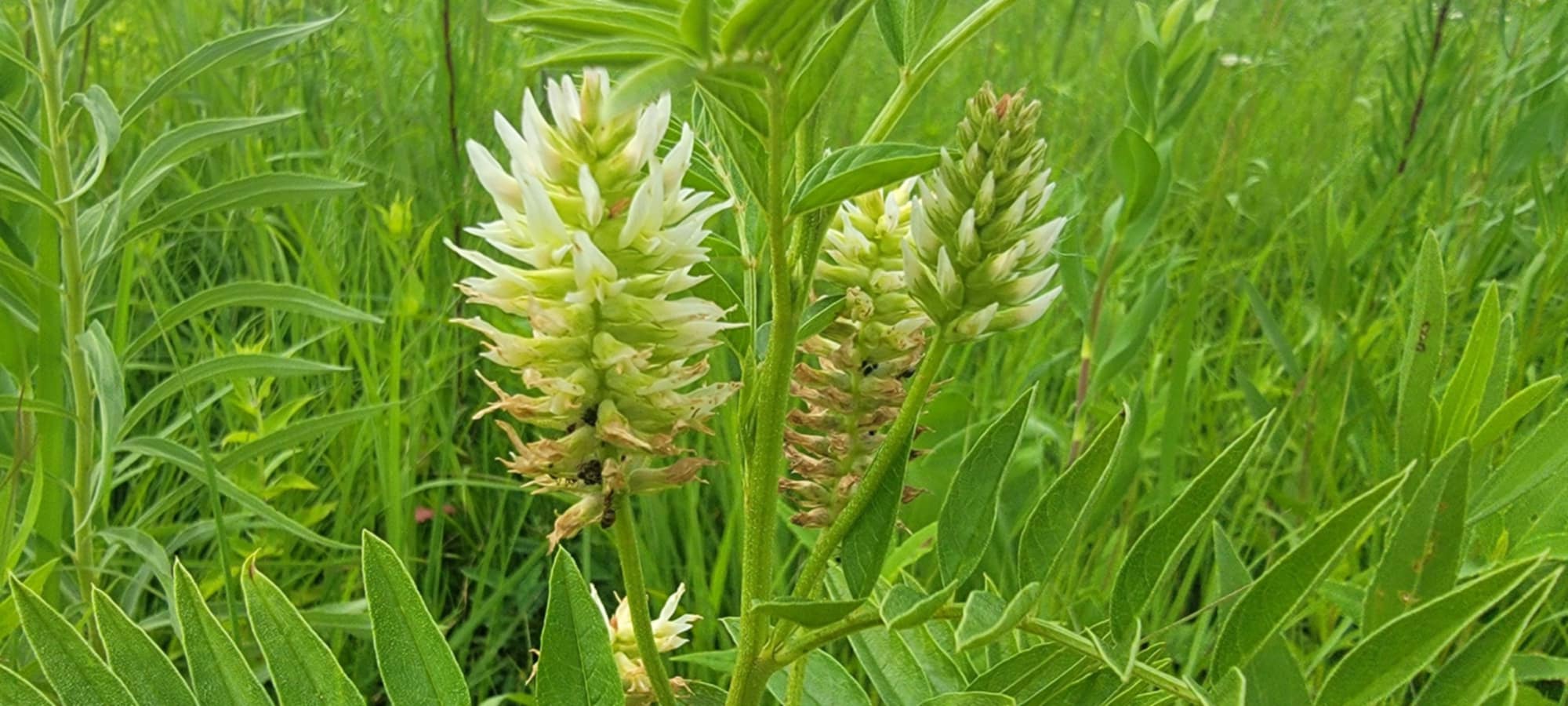Katie Byerly of Cerro Gordo County is also known as Iowa Prairie Girl on YouTube.
Apparently I take Wild licorice (Glycyrrhiza lepidota) growing in my “neck of the priairie” for granted. A map on the Iowa Wildflower app indicates that wild licorice grows in 22 of Iowa’s 99 counties, mostly in western Iowa. My home county, Cerro Gordo (north central Iowa), is on the eastern edge of this species’ known locations.
I find wild licorice growing in my favorite place to look for wildflowers: Wilkinson Pioneer Park in Rock Falls.

The plant can grow to be 3 feet tall, and I have seen plants reach that height. However, the wild licorice at Wilkinson barely made it to 2 feet this year. To me they look like little shrubs mixed in with other wildflower plants in the park’s sunny prairie. The leaves make up much of the plant.

The Missouri Plants website describes the leaves this way: “Alternate, odd-pinnately compound with 11-19 leaflets.” That means many leaves grow directly across from each other, and each leaflet has an odd number of leaves, with the odd one at the terminal end of the leaflet.

Here is the leaf description from Minnesota Wildflowers:
Leaflets are up to 1½ inches long and ½ wide, tapering to pointed or blunt tip, rounded or slightly tapered at the base, stalkless or nearly so, and often fold up some from the central vein especially when young. Edges are toothless, surfaces are hairless but gland-dotted, especially on the underside.
Here is a image of a leaf. If you look closely, you can see the glandular (oil) dots.

Wild licorice is in the legume or pea family. Like other legumes, it has irregular-shaped flowers with five petals. Many flowers are crowded on the spike-like, cone-shaped raceme.

Papilionaceous is a word used to describe flowers in the pea family. A long definition of papilionaceous names all five petals, including the larger top “banner” petal and two side “wing petals.” In simple terms, it means the flower looks like a butterfly (papilion is the Latin word for butterfly). I like the simple definition.

The flowers vary in color from white and cream to a pale yellow. These cylinder-shaped inflorescences shoot up from the point where the leaf attaches to the stem.

Wild licorice typically blooms in Iowa from from May to August. I took these images in north central Iowa on July 1.

This legume’s fruit or seed pod looks like a cocklebur. The plants use animals to distribute seeds; the oblong pods have hooked spines that catch on fur.

However, seeds don’t catch well on the smooth coats of Labrador retrievers.

Wild licorice’s name stems from the flavor of the taproot. Native Americans have used these plants for many medicinal purposes as well as for the flavor. The roots were used to sweeten tobacco, candy, and, of course, drink. They were also a food source.
Wikipedia shares that the explorers Lewis and Clark tried wild licorice during their journey: “After eating a roasted root in 1806, Meriwether Lewis described an ‘agreeable flavor not unlike the sweet pittaitoe (sweet potato).’[7]” The plants also spread into colonies via their sweet rhizomes.


I often take day trips and sometimes vacations just to look for different wildflowers. Although this sun-loving wildflower might not be as exciting as finding a rare orchid, it’s still a good one to check off in your field guide.
If you are ever in my “neck of the priarie,” look for wild licorice in the Rock Falls park. You might just run into Prairie Dog and me.



1 Comment
I've never seen a more delighted dog...
…than Prairie Dog. As a rural cat person who sees few dogs, I appreciate this opportunity to enjoy his happy face.
And the mention of the native range of wild licorice is a nice reminder that Iowa’s original prairies differ from each other. Each region of Iowa has its own unique assortment of native prairie plants. Prairie plantings that are intended to resemble original Iowa prairies should also differ from each other.
Western Iowa has wild licorice and eastern Iowa has wild quinine. Southern Iowa has rosinweed and northern Iowa has dwarf blazing star. An Iowa prairie planting can display the specific flowers, grasses, and sedges that are native to that particular planting site, and thereby help celebrate and protect Iowa’s prairie diversity.
PrairieFan Thu 1 Aug 6:00 PM